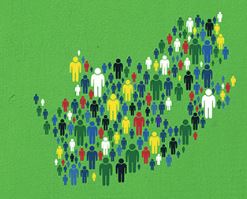
South Africa’s first digital census shows an increase in the proportion of households that had access to piped water inside their dwelling, from 32.3% in 2001 to 46.3% in 2011 and to 59.7% in 2022.
This is according to South Africa's Census 2022 national results, which was handed over to President Cyril Ramaphosa by Statistician-General Risenga Maluleke at the Union Buildings in Pretoria on Tuesday.
The data shows that in 2022 over four-fifths (82.4%) of households in the country had access to piped water either inside their dwelling or inside their yard.
“The proportion of households that accessed piped water off-site (from a water source outside the yard such as a neighbour or from a community stand) halved from 17.9% in 2011 to 8.9% in 2022.
“Households in the Western Cape were more likely to have piped water inside their dwelling (85.5%) compared to Limpopo, where less than one-third (31.4%) accessed piped water inside their dwelling.
“Although the national picture regarding access to piped water shows improvement over the years, there is a sizeable proportion of households in Limpopo (20.5%) and Eastern Cape (19.5%) with no access to piped water.
“The majority of households across the three censuses made use of a regional/local water scheme as their main source of water. This proportion increased steadily from 74.7% in 2001 to 79.7% in 2011 and to 82.7% in 2022,” Maluleke said.
There has been an increase in the percentage of households that used a flush toilet as their main type of toilet facility during this period (+18.9 percentage points).
However, the percentage of households that used a pit toilet without ventilation and households with no form of toilet facility declined during the same period, from 22.8% to 12.5% and from 13.6% to 1.6% respectively
Energy
The proportion of households using electricity as the main source of energy for lighting increased significantly from 58.1% in 1996 to 94.7% in 2022; conversely, the use of paraffin and candles as the main source of energy for lighting decreased.
Electricity was the main source of energy for lighting across all provinces.
In 1996, 28.8% of households utilised candles for lighting compared to the 3.2% in 2022.
The use of paraffin declined, with only 0.9% of households using it for lighting compared to the 12.7% in 1996.
“It is noted that the country recorded an upward trend in refuse removed by a local authority regularly, an increase from 52% in 1996 to 66% in 2022. Approximately two-thirds (66.3%) of households in the country had their refuse removed by a local authority once a week whilst one in four households used their own refuse dump (22.3%).
“The percentage of households with no refuse removal or using their own refuse dump both decreased over the same period. In 1996, 32.6% of households used their own refuse dump and 9.7% did not have any refuse removal,” he said.
In 2022, households using their own refuse dump decreased to 22.3% and those with no refuse removal halved to 4.5%
SA population
According to South Africa's Census 2022 national results, the population increased from 40.5 million in 1996 to just over 62 million in 2022; an increase of over 21.4 million people in 26 years.
“Black Africans remain consistently the dominant population group at a proportion of more than 80%, followed by the coloured and white populations at 8.2% and 7.3% in 2022, respectively.
“On the other hand, the Indian/Asian population comprised less than 3% of the population over the years. The age-sex structure indicates some decline in the ages between 0 and 29 years when compared to the 2011 distribution,” Maluleke said.
The sex ratio in the country decreased from 98.8 in 2011 to 94.1 in 2022. Gauteng reported the highest ratio at 101.8 in 2022, suggesting that there are more males than females in the province compared to the other provinces.
“Furthermore, the median age in the country was 28 years in 2022, showing an increase of three years from 25 years in 2011. It was highest in the Western Cape and lowest in Limpopo at 31 and 26 years, respectively.
“The median age of the white population was 45 years while that of the black African population was 27 years in 2022. The majority (62.2%) of the population has never been married, while 24% indicated that they are legally married,” Maluleke said.
The population and housing census was conducted in February 2022 and provides comprehensive data on population size, demographic trends, and other service delivery related information. – SAnews.gov.za


